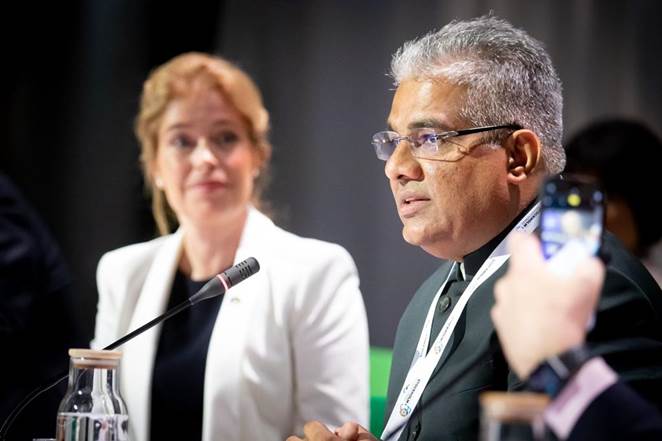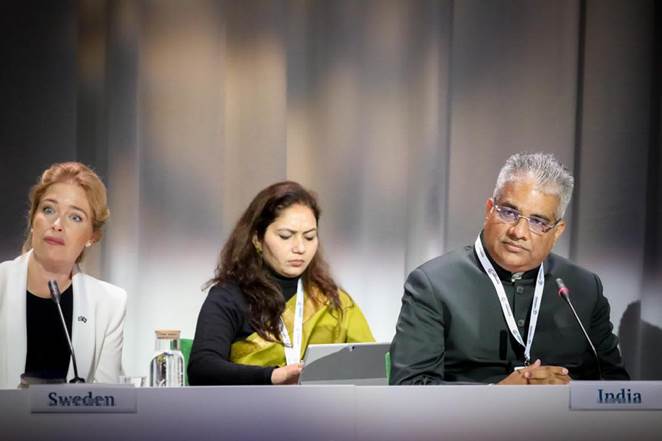




EHSQL team building , AMGreen and GreenkoGroupFounder Dr. Anil Chalamalasetty and Shri Mahesh Koli Sir,Shri Gautam Reddy,Dr.K.Pradeep,Dr. Rambabu P.,Shri H.Menon,Shri Ch.Srinivas Rao,Shri N. SeshaGiri, Shri GSV Raja,Shri GVS Anand,Shri K.GangadharRao,Shri Madhav KG Dr.V.S.John,Shri Badusha V. Shaik,Shri S. Simhachalam, Shri PVSN Raju,Shri B.B.K U.Maheswar Rao,Shri S.Tatayya,Shri P.Nagaraju,Shri S.K. Dash,Shri CH ApplaRaju,Shri LVV Rao, Shri P. Srinivaslu, EHSQL by Dr.A.N.GIRI-36.3Lakhs Viewed





Ministry of Environment, Forest and Climate Change
The Environmental Performance index 2022 released recently has many indicators based on unfounded assumptions. Some of these indicators used for assessing performance are extrapolated and based on surmises and unscientific methods.
The Ministry of Environment does not accept its analysis and conclusions for the following reasons: -
The detailed analysis of the flaws is given below:
Climate Policy is introduced as a new policy objective in 2022. Earlier it was part of the Ecosystem Vitality Objective as Climate Change issue category with a weight of 24%- in the last index . The weight of the policy objective is 38%. India is assigned a rank of 165 in this objective vis a vis is 106 earlier. This is because a few new parameters have been added in the policy objectives and weights have been modified.
Thus improvement in Tree Cover Loss and wetland loss categories for India is not linked to the projected emissions trajectory contrary to the NDC (nationally determined contribution) of Additional Carbon sink given by the country. Both forests and wetlands are crucial carbon sinks which are not reflected in the projected emissions.
II. For Environmental Health indicators-
III. The Ecosystem Vitality Policy Objective’s weightage has reduced from 60% to 42% in the total EPI.
India being an agrarian country has taken major steps towards the improvement of its agriculture sector and its practices such as Agro biodiversity, water use efficiency and soil health. With only two indicators under the Agriculture category the efforts of India towards the improvement of its agriculture sector and its practices are not reflected. Further in consonance with SDG 12, food waste and loss should be given due importance for agrarian economies to take care of vulnerability aspects which is also missing in the index.
The JRC report of 2020 states that the Fish Stock Status (FSS) and Fish caught by Trawling (FGT) are negatively correlated with the policy objective of Ecosystem Vitality as well as the EPI per se, though they are positively correlated with their issue category. Thus, refinement of the indicators was suggested, however, no major change in the parameters or their weights has been observed.
World Environment Day (WED) is celebrated on 5 June every year, and is the United Nations' principal vehicle for encouraging awareness and action for the protection of our environment. First held in 1974, it has been a flagship campaign for raising awareness on emerging from environmental issues to marine pollution, human overpopulation, and global warming, to sustainable consumption and wildlife crime. World Environment Day has grown to become a global platform for public outreach, with participation from over 143 countries annually. Each year, WED has a new theme that major corporations, NGOs, communities, governments and all celebrities worldwide adopt to advocate environmental causes.






Q: Why is World Environment Day celebrated June 5th?
World Environment Day is held each year on June 5. It is one of the principal vehicles through which the United Nations (UN) stimulates worldwide awareness of the environment and enhances political attention and action.
Q: When was the first World Environment Day celebrated?
World Environment Day [WED] was established by the UN General Assembly in 1972 on the first day of the Stockholm Conference on the Human Environment, resulting from discussions on the integration of human interactions and the environment..
Q: Who founded Environment Day?
World Environment Day [WED] was established by the UN General Assembly in 1972 on the first day of the Stockholm Conference on the Human Environment, resulting from discussions on the integration of human interactions and the environment.
Who started environment day?
On the first day of the Stockholm Conference on Human environment in 1972, The World Environment Day was established by the United Nations.
Since its beginning in 1972, World Environment Day has developed into a global platform for raising awareness as well as taking action on urgent issues from marine pollution and global warming to sustainable development and wildlife crime. Millions of people have taken part over the years, helping drive change in our consumption habits of natural resources alongwith national and international environmental policy.
World Environment Day is the biggest international day for the environment, led by the United Nations Environment Programme (UNEP), and held annually since 1974. It has grown to be the largest global platform for environment outreach. It is celebrated by millions of people across the world. This year, World Environment Day 2022 is hosted by Sweden. “Only One Earth” is the campaign slogan, with the focus on “Living Sustainably in Harmony with Nature”. KIIT DU celebrating this day by organising an INTERNATIONAL CONFERENCE ON “LIVING SUSTAINABILITY IN HARMONY WITH NATURE”, during June 4th – 5th, 2022.
What can I do for world environment day?
Spread awareness- It is very important for everyone to be aware of things happening to our environment, especially when the reason behind this catastrophe is us! Spread awareness through billboards, door-to-door campaign, pamphlets, completions, power point presentation, short skits and many more.
Start from home - charity begins from home, this is self explanatory. We need to start bringing changes from within ourselves by realising
Ministry of Environment, Forest and Climate Change
India and Sweden hosted the Industry Transition Dialogue today in Stockholm, as a part of their joint initiative i.e. Leadership for Industry Transition (LeadIT). The LeadIT initiative lays specific focus on hard to abate sectors that are key stakeholders in the global climate action and require specific interventions.
This high level of dialogue has contributed to the UN Conference ‘Stockholm+50’: a healthy planet for the prosperity of all –our responsibility, our opportunity’, takingplace on 2 and 3 June 2022 and set the agenda for COP27.
The event was opened by address from Union Minister of Environment, Forest and Climate Change, India, Shri Bhupender Yadav and Minister for Climate and the Environment, Sweden, Ms. Annika Strandhäll.

In the opening address the Union Minister congratulated the world for the upcoming 50th anniversary of United Nations Conference on the Human Environment that took place in 1972 and put environmental issues at the forefront of the international concerns. He emphasized that it is the time to celebrate 50 years of collaborative action, at the same time to introspect on what has been achieved and what more is yet to be done. “The developing world needs not just an industrial ‘transition’, but an industrial renaissance – a flowering of industries that will create jobs and prosperity along with a clean environment. The developed nations, with their historical experiences, must take lead in the global transition towards net-zero & low carbon industry.”, the minister stated.

Japan and South Africa, the latest members of the initiative were welcomed. This extends the total membership of LeadIT to 37 including countries and companies together. The minister also updated the audience about the progress made under the initiative that includes the sectoral road mapping, workshops and industrial field visits to facilitate knowledge sharing and combined efforts.
During the event, India chaired the roundtable dialogues on Priorities for implementation 2022-23. The need for speed and scale in climate action was echoed by all the speakers. The countries and companies shared their initiatives, success stories and plans for future. Some very specific and valuable insights were shared by the participants. It was felt that the domestic actions if implemented and communicated well can be valuable inspiration at the international level. The efforts and exchanges through such platforms have the potential to lead the world in right direction. The commitments and pledges now must translate into action in mitigation and adaptation that rides on climate finance and technology transfer.
***
BY